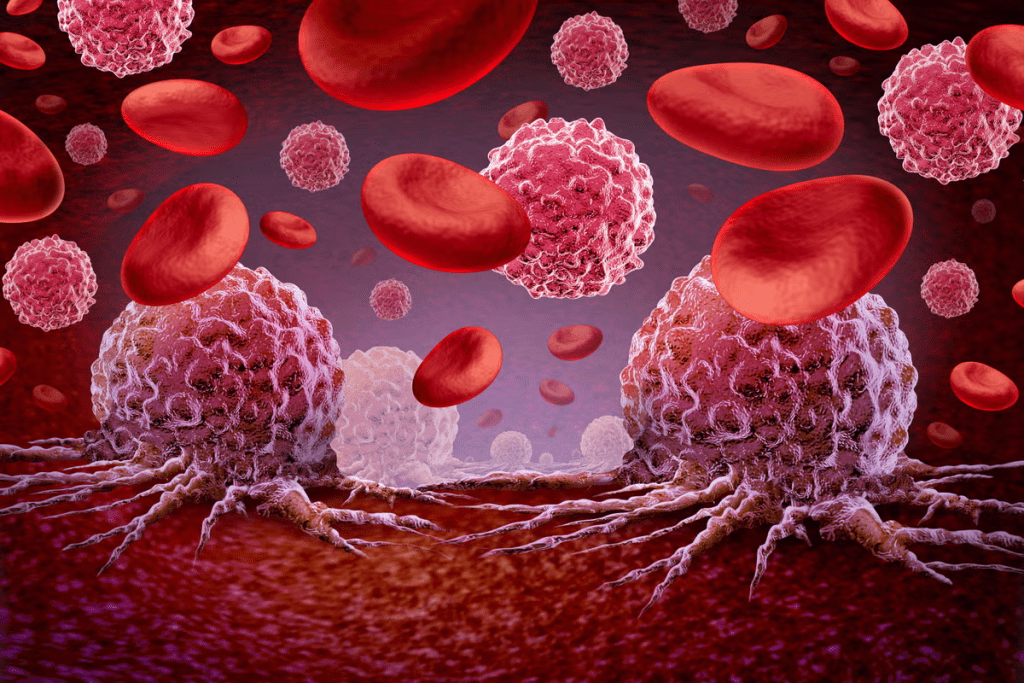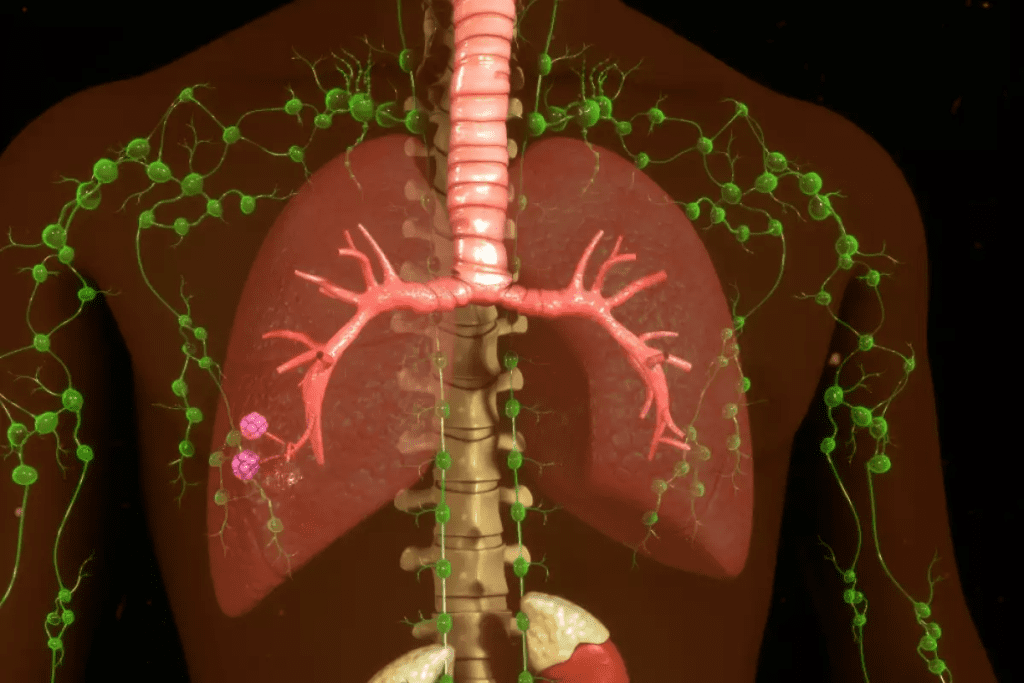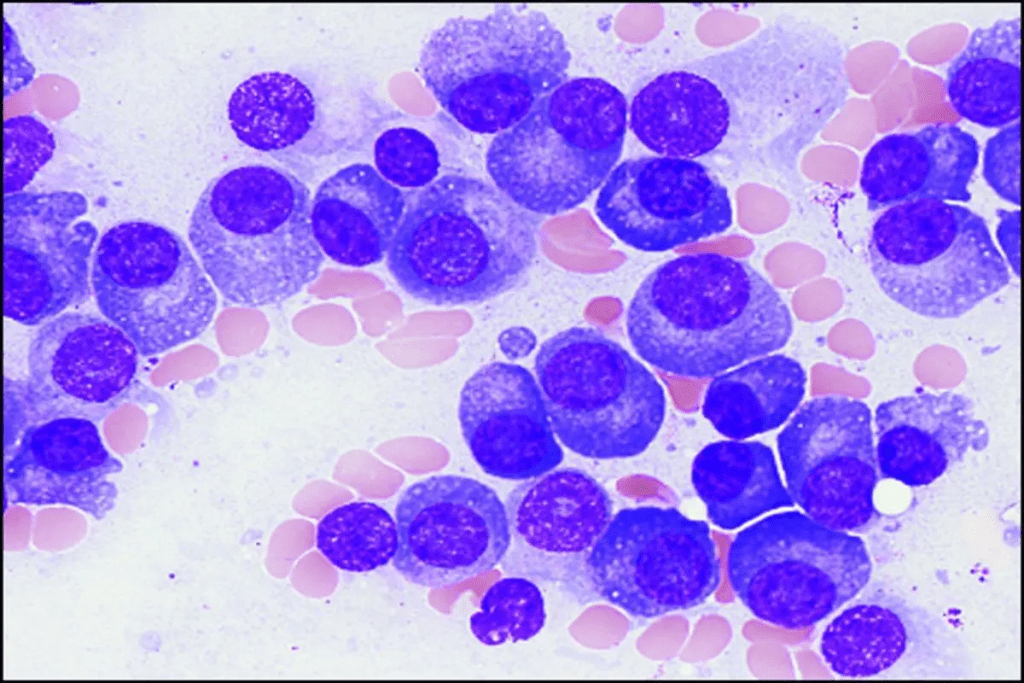Last Updated on October 21, 2025 by mcelik

Did you know that blood cancer, also known as hematologic cancer, affects over 1 million people worldwide each year? This is a huge number that shows how important it is to understand this disease.
We’re here to help you learn about the types of hematologic cancer. This includes leukemia, lymphoma, and myeloma. We’ll also find out which one is the most curable.
Understanding types of blood cancer and its treatments is key for patients and their families. We’ll give you an overview of blood cancer treatment today. We’ll also explain why some types are more curable than others.
Blood cancer is a term for diseases where blood cells grow abnormally. It can make it hard for the body to fight off infections and heal. We’ll look into what blood cancer is and how it starts.
Blood cancer, or cancer of the blood, happens when blood cells grow too much. This can occur in the bone marrow or lymph nodes. There are three main types: leukemia, lymphoma, and myeloma. Each affects different blood cells and has its own traits.
The concept of a ‘cure’ in blood cancer is evolving.
The start of blood cancer involves complex biological steps. It begins with genetic mutations in blood cells’ DNA, causing them to grow uncontrollably. These mutations can come from genetic factors, exposure to chemicals, or viral infections.
As these abnormal cells build up, they can block the production of normal blood cells. This leads to various health problems. Knowing how blood cancer starts is key to finding good treatments.
“Blood cancer” is a term for cancers that affect the blood, bone marrow, and lymphatic system. It includes leukemia, lymphoma, and myeloma. Knowing about these types is key for proper diagnosis and treatment.
The concept of a ‘cure’ in blood cancer is evolving.
Key characteristics of leukemia include:
Lymphoma affects the lymphatic system, which is part of the immune system. It starts when lymphocytes (a type of white blood cell) grow out of control.
Main features of lymphoma:
The concept of a ‘cure’ in blood cancer is evolving.
Notable aspects of myeloma:
Each blood cancer needs its own diagnosis and treatment plan. This shows why it’s so important to know the exact type of blood cancer.
The concept of a ‘cure’ in blood cancer is evolving.
Acute Lymphoblastic Leukemia (ALL) is a fast-growing leukemia. It’s the most common cancer in kids and has a high cure rate, mainly in children. ALL is caused by too many immature lymphocytes.
Acute Myeloid Leukemia (AML) is a fast-growing leukemia that affects myeloid cells in the bone marrow. It can happen at any age but is more common in adults. The outcome depends on age and genetic mutations.
Chronic Lymphocytic Leukemia (CLL) is a slow-growing leukemia that affects lymphoid cells. It’s more common in older adults and often found during routine blood tests. CLL treatment varies based on stage and symptoms.
Chronic Myeloid Leukemia (CML) is marked by uncontrolled growth of myeloid cells in the bone marrow. CML is linked to a specific genetic abnormality called the Philadelphia chromosome. Treatment for CML has improved with new targeted therapies.
Understanding the different types of leukemia helps tailor treatment plans. The table below summarizes the key aspects of these leukemia types.
| Type of Leukemia | Characteristics | Common Age Group | Treatment Approach |
| Acute Lymphoblastic Leukemia (ALL) | Rapid progression, immature lymphocytes | Children and young adults | Chemotherapy, targeted therapy |
| Acute Myeloid Leukemia (AML) | Aggressive, affects myeloid cells | Adults | Chemotherapy, stem cell transplant |
| Chronic Lymphocytic Leukemia (CLL) | Slow progression, affects lymphoid cells | Older adults | Watchful waiting, targeted therapy |
| Chronic Myeloid Leukemia (CML) | Uncontrolled growth of myeloid cells | Adults | Targeted therapy (Tyrosine kinase inhibitors) |
The treatment for leukemia varies based on the type, stage, and patient’s health. Medical research has improved outcomes for many patients. We’re seeing new treatments that offer hope for better survival rates and quality of life.

Lymphoma is a cancer that affects the lymphatic system. It has many subtypes. The lymphatic system helps fight off infections. Different lymphomas have their own traits and treatment plans.
Hodgkin lymphoma is marked by Reed-Sternberg cells. These are abnormal lymphocytes seen under a microscope. It’s a rare type of lymphoma that spreads in a certain order.
Non-Hodgkin lymphoma is a group of lymphomas without Reed-Sternberg cells. It can happen anywhere in the body. Its aggressiveness and treatment response vary a lot.
Knowing the difference between Hodgkin and Non-Hodgkin lymphoma is key. Both can cause swollen lymph nodes. But, their outlook and treatment vary a lot.
| Characteristics | Hodgkin Lymphoma | Non-Hodgkin Lymphoma |
| Presence of Reed-Sternberg Cells | Yes | No |
| Disease Progression | Orderly progression | Variable, can be widespread |
| Age of Onset | Bimodal (20s and 50s) | Generally increases with age |
Understanding these differences helps doctors create better treatment plans. This improves patient outcomes.

It’s important to understand multiple myeloma and other plasma cell disorders. This knowledge helps in early diagnosis and treatment. We will look into their characteristics, how to diagnose them, and treatment choices.
Multiple myeloma is a cancer of plasma cells. It can cause bone damage and anemia. The disease happens when bad plasma cells fill the bone marrow, pushing out healthy cells.
Common symptoms include bone pain, fatigue, and frequent infections.
Myeloma symptoms can differ from person to person. But, they often include:
There are other rare plasma cell cancers, like solitary plasmacytoma and plasma cell leukemia. These are less common but need quick diagnosis and treatment.
| Condition | Description | Common Symptoms |
| Multiple Myeloma | Cancer of plasma cells in bone marrow | Bone pain, fatigue, infections |
| Solitary Plasmacytoma | A single tumor of plasma cells | Localized pain, sometimes asymptomatic |
| Plasma Cell Leukemia | Presence of plasma cells in blood | Fatigue, weight loss, infections |
We will keep exploring how to diagnose and treat these plasma cell disorders. This will be in the next sections.
Whether blood cancer is curable depends on many things. It’s important to know the details about blood cancer’s curability.
A renowned hematologist, says, “The concept of a ‘cure’ in blood cancer is evolving. New treatments make what was once impossible now possible.”
Many things affect if blood cancer can be cured. These include:
Knowing these factors helps doctors predict outcomes and plan treatments.
The concept of a ‘cure’ in blood cancer is evolving.
“Advances in medical treatments have significantly improved survival rates for blood cancer patients across all age groups, giving new hope to those affected by this disease.”
For example, kids under 20 have a better chance of survival than older patients. This shows how important early diagnosis and treatment are.
Every person’s fight with blood cancer is different. Knowing what affects curability is essential for dealing with this complex disease.
The concept of a ‘cure’ in blood cancer is evolving.
Blood cancer often shows symptoms that can look like other illnesses. Look out for persistent fatigue, unexplained weight loss, and frequent infections. You might also notice swollen lymph nodes, easy bruising, or painless lumps in certain areas.
Diagnosing blood cancer requires several tests. The first step is usually a complete blood count (CBC). This checks for abnormal blood cells. If the CBC shows something off, more tests like bone marrow biopsy and aspiration are done to confirm the diagnosis.
Other tests might include imaging studies like CT scans or MRI. These help see how far the disease has spread. Molecular and genetic testing also help identify the cancer’s specific traits. This information helps doctors plan the best treatment.
After diagnosing blood cancer, it’s staged to see how far it has spread. The staging method depends on the type of cancer. For example, lymphoma uses the Ann Arbor Staging System. Leukemia is classified based on its type and the number of cancer cells.
| The concept of a ‘cure’ in blood cancer is evolving. | Staging System | Factors Considered |
| Lymphoma | Ann Arbor Staging System | Location and number of lymph node groups involved |
| Leukemia | Classification based on cell type and count | Number of cancer cells in blood and bone marrow |
| Myeloma | Durie-Salmon Staging System | Levels of M protein, calcium, and bone lesions |
Knowing the stage of blood cancer is key for planning treatment. We’ll look at treatment options next.
The treatment for blood cancer has changed a lot, giving patients new hope. Medical research has led to many effective treatments. These are tailored to the type and stage of blood cancer.
The concept of a ‘cure’ in blood cancer is evolving.
Chemotherapy regimens often use more than one drug. This makes them more effective against cancer cells.
Radiation therapy uses high-energy rays to kill cancer cells. It’s not as common for blood cancers as for solid tumors. But, it’s used in certain situations, like:
Stem cell transplantation, including bone marrow transplantation, is key for many blood cancers. It replaces damaged stem cells with healthy ones. This allows for:
Targeted therapies and immunotherapies are big steps forward in treating blood cancer. They include:
These treatments are more precise and often have fewer side effects than traditional chemotherapy.
| Treatment Modality | Description | |
| Chemotherapy | Drugs to kill cancer cells | Leukemia, Lymphoma, Myeloma |
| Radiation Therapy | High-energy rays to kill cancer cells | Lymphoma, preparing for stem cell transplant |
| Stem Cell Transplantation | Replacing damaged stem cells | Leukemia, Lymphoma, Myeloma |
| Targeted Therapies | Drugs targeting specific cancer cell features | CML, CLL, certain Lymphomas |
| Immunotherapies | Boosting the immune system to fight cancer | Relapsed/refractory Leukemia and Lymphoma |
We’re seeing big improvements in blood cancer treatments. This means better outcomes and quality of life for patients. The right treatment depends on the type of blood cancer, its stage, and the patient’s health.
Acute Lymphoblastic Leukemia (ALL) is a highly curable blood cancer, mainly in children. We will look at why it has such high cure rates and the effective treatments used.
Several factors lead to high cure rates in ALL patients. The disease responds well to chemotherapy. Treatment plans are well set up, which helps kids a lot.
Key Factors:
Treatment for ALL includes strong chemotherapy. These plans aim to get the disease into remission. Then, they focus on keeping it away with more treatment phases.
ALL has high cure rates, with kids doing best. Survival rates over 90% have been seen in some studies. Adults also see better results with new treatments, but not as high as kids.
| Age Group | 5-Year Survival Rate |
| Children | 90% |
| Adults | 40-50% |
Research keeps improving ALL treatments. This work aims to help all patients, not just kids.
The world of blood cancer treatment is changing fast. Hodgkin lymphoma and hairy cell leukemia are now more treatable. Acute Lymphoblastic Leukemia (ALL) is already very curable. Other blood cancers are also seeing better treatment results.
Hodgkin lymphoma is a cancer of the lymphatic system. Thanks to new treatments like chemotherapy, radiation, and immunotherapy, it’s getting easier to treat. These new methods have greatly helped patients.
Key Treatment Advances in Hodgkin Lymphoma:
Studies show that more patients with Hodgkin lymphoma are surviving longer. Many are even in long-term remission.
The concept of a ‘cure’ in blood cancer is evolving.
| Treatment | Outcome |
| Tyrosine Kinase Inhibitors (TKIs) | Significant improvement in survival rates |
| Personalized treatment plans | Better management of side effects |
TKIs have greatly improved CML patient outcomes. Now, many can live active lives.
Hairy cell leukemia, a rare cancer, has seen big treatment improvements. Targeted therapies have made a big difference. Other non-Hodgkin lymphoma types are also getting better treatments.
Notable treatments for hairy cell leukemia include:
These treatments have boosted response rates and survival for hairy cell leukemia patients.
It’s important to know what affects blood cancer treatment success. Many factors play a role, which we will discuss.
Age and health are key in treating blood cancer. Younger people often do better because they have fewer health issues. Patients under 60 usually have a higher chance of survival. But, overall health matters too, including other health problems.
| Age Group | 5-Year Survival Rate |
| 20-39 years | 70% |
| 40-59 years | 60% |
| 60-79 years | 40% |
| 80+ years | 20% |
Genetics and molecular factors greatly affect blood cancer treatment. Some genetic changes can make cancer harder to treat. Patients with certain genes may get better with specific treatments. Knowing these details helps doctors create better plans for each patient.
How well a patient responds to the first treatment is very important. Those who get rid of cancer completely after the first treatment usually do well. Watching how well treatment works helps doctors make changes to help more.
Seeing doctors who specialize in blood cancers is very important. Patients at specialized centers often do better because of the team approach. They get the newest treatments and join clinical trials.
By focusing on these areas, we can make blood cancer treatment more effective. It’s about looking at each patient’s needs and using the latest in medicine.
Advances in targeted therapies and immunotherapies are changing how we treat blood cancers. Recent years have brought big steps in understanding these diseases. This has led to treatments that are more effective and less harmful.
Targeted therapies are a big hope in blood cancer research. These treatments aim directly at cancer cells, protecting healthy cells and reducing side effects. For example, tyrosine kinase inhibitors (TKIs) have greatly improved treatment for Chronic Myeloid Leukemia (CML).
Immunotherapies, like CAR-T cell therapy, are also showing great promise. They use the body’s immune system to fight cancer, even in patients who have tried many treatments before.
Clinical trials are exploring new ways to treat blood cancers. Researchers are looking at combining existing treatments and trying new approaches like bispecific antibodies and cancer vaccines.
Bispecific T-cell engagers (BiTEs) are being tested in Acute Lymphoblastic Leukemia (ALL) and other aggressive blood cancers. They bring T-cells close to cancer cells, making the immune system attack the cancer.
| Therapy Type | Description | Potential Benefits |
| Targeted Therapies | Drugs that target cancer cells | Less side effects, better results |
| Immunotherapies | Uses the immune system to fight cancer | Chance for complete remission, long-lasting results |
| Bispecific Antibodies | Molecules that connect T-cells with cancer cells | Works well for aggressive blood cancers |
As research keeps moving forward, we’ll see more tailored and effective treatments for blood cancer. Genomic profiling, artificial intelligence, and machine learning will be key in this progress.
Also, more collaboration among researchers will speed up the discovery of new treatments. This will help more patients get access to the latest treatments.
Blood cancer includes types like leukemia, lymphoma, and myeloma. Each has its own traits and treatment ways. Thanks to medical progress, many patients now have a chance for a cure.
New treatments like targeted therapies and immunotherapies have changed how we fight blood cancer. For example, Acute Lymphoblastic Leukemia (ALL) is now more treatable. This is thanks to modern treatments.
Understanding and treating blood cancer has given patients hope. Ongoing research and trials suggest a bright future. More people might find a cure, leading to longer, healthier lives.
As research finds new treatments, the outlook for blood cancer patients gets better. We’re dedicated to top-notch healthcare and support. We help patients on their path to recovery.
Blood cancer, also known as hematologic cancer, affects the blood, bone marrow, or lymphatic system. It happens when blood cells grow abnormally. This can cause many health issues.
The concept of a ‘cure’ in blood cancer is evolving.
Acute Lymphoblastic Leukemia (ALL) is very curable, mainly in children. Modern treatments can cure ALL in kids up to 90%. In adults, the cure rate is about 40-50%.
Symptoms include fatigue, weight loss, fever, and night sweats. Swollen lymph nodes and frequent infections are also common. Some people may feel bone pain, anemia, or bleeding disorders.
Doctors use physical exams, blood tests, bone marrow biopsies, and imaging like CT or PET scans. A diagnosis is made when abnormal cells are found in the blood or bone marrow.
Treatments include chemotherapy, radiation, stem cell transplants, targeted therapies, and immunotherapies. The right treatment depends on the cancer type, stage, and the patient’s health.
Yes, some blood cancers can be cured, mainly if caught early. The chance of a cure varies by cancer type, stage, and treatment response.
Survival rates vary by cancer type, stage, age, and health. Generally, the five-year survival rate for all blood cancers is about 60-70%.
Age is key in blood cancer treatment. Younger patients usually do better than older ones. They can handle more aggressive treatments and have fewer health problems.
New treatments include targeted therapies, immunotherapies, and CAR-T cell therapy. These have shown great promise in trials and are changing treatment options.
Yes, many clinical trials for blood cancer are ongoing. They explore new treatments and combinations. Patients should talk to their doctors about joining a trial.
Subscribe to our e-newsletter to stay informed about the latest innovations in the world of health and exclusive offers!